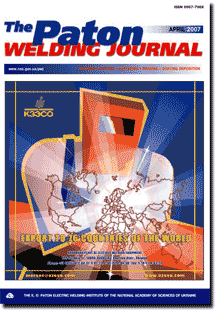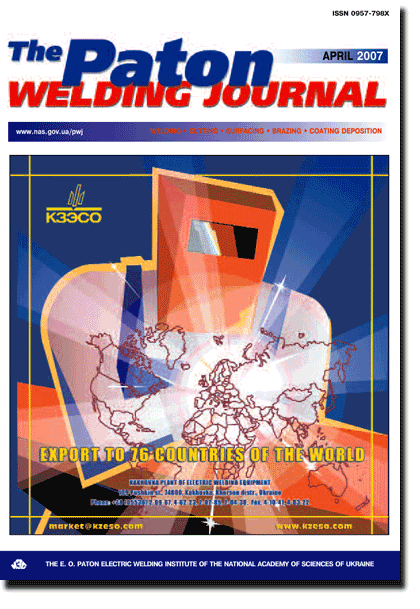

| SCIENTIFIC AND TECHNICAL | |
| Belous V.Yu. and Akhonin S.V. Influence of controlling magnetic field parameters on weld formation in narrow-gap argon-arc welding of titanium alloys | 2 |
| The efficiency of application of narrow-gap nonconsumable-electrode argon-arc welding of titanium alloys of У 20 mm thickness is noted. It is shown that in order to provide a reliable fusion in the joints when using a transverse variable magnetic field, the value of magnetic inductance in the arc zone should be equal to 8Д9 mT. Minimum penetration of the side walls is achieved at the field frequency of 10 Hz. | |
| Tsybulkin G.A. Compensation of external disturbance action on consumable electrode arc welding mode | 5 |
| The paper deals with one of approaches to reducing the influence of external disturbances on the arc welding mode parameters, based on application of the absorption principle. The procedure of structural synthesis of compensating feedback is described. Results of mathematical simulation are presented. | |
| Giridharan P.K. and Murugan N. Study on the effect of pulsed GTAW process parameters on bead geometry of the AISI 304L stainless steel welds | 9 |
| A study on the effect of pulsed gas tungsten arc welding (GTAW) parameters on weld bead geometry was carried out for welding of the 304L stainless steel sheets of 3 mm thickness. Autogenous welding with square butt joint was employed. The advantages of pulsed GTAW process, such as controlled heat input, increased depth to width ratio and less distortion etc., can be achieved only when the welding parameters were thoroughly studied, controlled and optimized through mathematical models. Hence, mathematical models were developed correlating the important controllable pulsed GTAW process parameters like pulse current, pulse duration and welding speed with weld bead parameters, such as penetration, bead width, aspect ratio and bead area of the weld. A design of experiments based on central composite rotatable design was employed. The developed models were found to be adequate based on regression and ANOVA analysis. The models were validated by plotting scatter diagram and by conducting confirmation test. Weld bead parameters predicted by the models were found to confirm with observed value with high accuracy. Using these models, the main and interaction effects of pulsed GTAW parameters on weld bead parameters can be studied. Optimization of the process parameters was also carried out to obtain optimum bead parameters using quasi-newtonian numerical optimization technique. Results of the optimization were also presented in this paper. | |
| Lebedev V.A. Dependence between the rates of pulsed wire feed and wire melting in welding with short-circuiting | 17 |
| Mathematical model is considered, describing the dependence of the arc process current and the rate of melting of electrode wire on the varying nature of its motion in the process of consumable electrode arc welding, in particular, in short-circuiting of the arc gap. | |
| Gedrovich A.I., Tkachenko A.N., Tkachenko S.A., Zelnichenko A.T., Alekseenko I.I. and Bondarenko V.L. Peculiarities of structure and properties formation in 10Kh13G18D steel fusion zone | 20 |
| Peculiarities of the reaction of austenitic steel 10Kh13G18D in the form of cold-rolled stock to the thermodeformational cycle of arc welding are considered. The nature of phase transformations in the fusion zone of steel 10Kh13G18D in similar and dissimilar joints with steel 09G2S is shown. Reduction of welding heat input prevents to a considerable degree the metal softening in the fusion zone of welded joints and reduces the probability of precipitation of d-ferrite in this zone. | |
| Labur T.M., Ishchenko A.Ya., Taranova T.G., Kostin V.A., Grigorenko G.M. and Chajka A.A. Influence of thermophysical conditions of welding on fracture resistance of the HAZ metal in the joints of aluminium alloy V96tss | 25 |
| Considered is the influence of volume fraction, morphology and composition of particles containing zirconium and scandium on fracture resistance characteristics of the HAZ metal of a high-strength complex-alloyed aluminium alloy V96tss in fusion arc and electron beam welding. | |
| INDUSTRIAL | |
| Makhnenko V.I., Makhnenko O.V. and Zinchenko O.Ya. Investigation of performance of welded joints in steam generators PGV-1000M by leak tests | 31 |
| Increase in excessive pressure in the case of using the air-hydraulic aquarium method for testing leak-tightness of steam generators PGV-1000M leads to increase in gap between a heat exchanger pipe and collector wall. As a result, extra stresses are formed at the gap tip (weld root), which may lead to violation of integrity by the mechanism of initiation of a crack-like design defect. The risk of initiation of fracture with growth of excessive pressure is estimated. | |
| Neklyudov I.M., Borts B.V., Vanzha A.F., Lopata A.T., Rybalchenko N.D., Sytin V.I. and Shevchenko S.V. Improvement of quality of permanent joints Е way to prolongation of service life of heat-generating assemblies | 37 |
| Possibilities of producing stable permanent joints of zirconium-base alloys and stainless steel, used in fuel rods of a number of nuclear reactors, and in sensors and probes of the reactor control instruments are investigated. By the method of solid phase welding joints of zirconium and stainless steel with interlayers from niobium and copper are investigated, which allow the items working in corrosive environment under conditions of thermocycling and alternating loading. Connection between structural changes of the composite and its weakening in the process of action on it of variable thermal fields is studied. | |
| Blashchuk V.E. TIG welding of titanium and its alloys (Review) | 41 |
| Peculiarities of utilisation of TIG welding methods for joining titanium and its alloys are considered. Recommendations are given for application of different welding methods, and their advantages and drawbacks are noted. | |
| Borisov Yu.S., Panko M.T. and Rupchev V.L. Methods for manufacture of powders with quasi-crystalline component for thermal spraying of coatings (Review) | 47 |
| Analysis of the state-of-the-art in methods for manufacture of powders of quasi-crystalline alloys has been conducted. It is shown that the most suitable method to manufacture powders for thermal spraying, among those available now, is compressed air atomisation of the melt, which provides powders with a high content of the quasi-crystalline phase and high workability (flowability). | |
| BRIEF INFORMATION | |
| Zhernosekov A.M. and Kislitsyn V.M. Efficiency enhancement of gas generators of hydrogen-oxygen mixture | 51 |
| It is established that application of pulsed arc power sources with smooth adjustment of the pulse parameters and increased repetition rate allows increasing the electrolyzer efficiency. | |
| Developed at PWI | 16 30 50 52 |
(You are viewing the simplified file contents)
The cost of subscription/purchase order journals or individual articles
| Journal/Currency | Annual Set | 1 issue printed |
1 issue |
one article |
| TPWJ/USD | 384 $ | 32 $ | 26 $ | 13 $ |
| TPWJ/EUR | 348 € | 29 € | 24 € | 12 € |
| TPWJ/UAH | 7200 UAH | 600 UAH | 600 UAH | 280 UAH |
| AS/UAH | 1800 UAH | 300 UAH | 300 UAH | 150 UAH |
| AS/USD | 192 $ | 32 $ | 26 $ | 13 $ |
| AS/EUR | 180 € | 30 € | 25 € | 12 € |
| SEM/UAH | 1200 UAH | 300 UAH | 300 UAH | 150 UAH |
| SEM/USD | 128 $ | 32 $ | 26 $ | 13 $ |
| SEM/EUR | 120 € | 30 € | 25 € | 12 € |
| TDNK/UAH | 1200 UAH | 300 UAH | 300 UAH | 150 UAH |
| TDNK/USD | 128 $ | 32 $ | 26 $ | 13 $ |
| TDNK/EUR | 120 € | 30 € | 25 € | 15 € |
AS = «Automatic Welding» - 6 issues per year;
TPWJ = «PATON WELDING JOURNAL» - 12 issues per year;
SEM = «Electrometallurgy Today» - 4 issues per year;
TDNK = «Technical Diagnostics and Non-Destructive Testing» - 4 issues per year.


